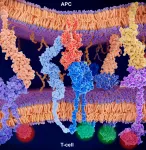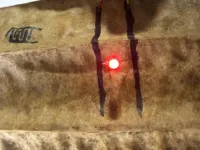(Press-News.org) DALLAS - Jan. 6, 2020 - UT Southwestern scientists have developed a new method to study the molecular characteristics of T cells, critical immune cells that recognize and attack invaders in the body such as viruses, bacteria, and cancer.
The approach, described today in the journal Nature Methods, enables researchers to more easily analyze the roles of T cell receptors (TCRs) - the molecules on the surfaces of T cells that are responsible for recognizing pathogens.
"This could lead to a better understanding of how T cells work as well as new ways to harness T cells to fight disease," says study leader Tao Wang, Ph.D., assistant professor of population and data sciences and a member of the Quantitative Biomedical Research Center at UTSW.
While some immune cells can simultaneously attack different pathogens, T cells are more targeted - every individual T cell has a distinct set of T cell receptors (TCRs) on its surface. Each receptor usually recognizes only one specific molecule, or "antigen." One TCR, for instance, might bind only to a protein found in lung cancers, while a different TCR might bind just to an influenza virus. When a T cell encounters an antigen that binds to one of its TCRs, it becomes activated, prompting an immune response. To ward off the diverse set of potential invaders, humans have millions of different T cells in their bodies.
Scientists have attempted to study what makes different T cells and TCRs more or less effective, hampered so far by a lack of information about what various TCRs do. Generally, they assume that TCRs that look alike must bind to similar antigens, and that all TCRs activate T cells in a similar way.
To eliminate this guesswork, the research team developed a statistical model combining two existing technologies: TCR analysis, which measures a person's TCR diversity, and single-cell RNA sequencing, which identifies the particular genes that are turned on or off in a T cell. Combining these technologies has been challenging since they both generate many thousands of pieces of data per experiment, and the data comes in two different forms. The new model, dubbed Tessa, uses powerful statistical methods to bridge this gap. Tessa reveals what happens to an individual T cell when its TCR recognizes an antigen, and in what way TCRs impact the function of the T cells. (Tessa stands for TCR functional landscape estimation supervised with scRNA-sequencing analysis.)
Using Tessa, the researchers studied 100,288 T cells from both healthy people and cancer patients. In cancer patients, they discovered that the variety of TCRs in T cells has a weaker influence on the functional status of T cells than on those found in healthy patients. This is likely because a plethora of other immune molecules, secreted into the tumor micro-environment, are influencing T cell activity in other ways. This observation - and others that are likely to result from more widespread use of Tessa - could have implications for scientists designing immune-based cancer treatments.
David Gerber, M.D., professor of internal medicine and population and data sciences, and associate director of clinical research in the Harold C. Simmons Comprehensive Cancer Center at UT Southwestern, believes this work provides a completely new way of using single T cell sequencing data. "We envision deploying this promising tool to study the roles of T cells in immune-related adverse events caused by cancer immunotherapy through a recently funded NIAID U01 award," he says.
"Previous techniques have involved a lot of guessing when it comes to the exact function of T cells and how T cell receptors associate with function," adds Todd Aguilera, M.D., Ph.D., a UTSW assistant professor of radiation oncology, and an expert in immunotherapy, who is also collaborating with Wang. "I believe this method could help the identification of the most promising TCRs for personalized TCR-based immunotherapy and better define productive immune responses to guide identification of the optimal immunotherapy strategies."
INFORMATION:
Other researchers on the study were Ze Zhang (first author), a UTSW graduate, Hongyu Liu, an exchange scholar at UTSW, and Danyi Xiong and Xinlei Wang of Southern Methodist University. This research was supported by funds from the National Institutes of Health (CCSG 5P30CA142543) and the Cancer Prevention and Research Institute of Texas (RP190208).
About UT Southwestern Medical Center
UT Southwestern, one of the premier academic medical centers in the nation, integrates pioneering biomedical research with exceptional clinical care and education. The institution's faculty has received six Nobel Prizes, and includes 23 members of the National Academy of Sciences, 17 members of the National Academy of Medicine, and 13 Howard Hughes Medical Institute Investigators. The full-time faculty of more than 2,500 is responsible for groundbreaking medical advances and is committed to translating science-driven research quickly to new clinical treatments. UT Southwestern physicians provide care in about 80 specialties to more than 105,000 hospitalized patients, nearly 370,000 emergency room cases, and oversee approximately 3 million outpatient visits a year.
Philadelphia, January 6, 2021 - A multidisciplinary team of researchers led by Children's Hospital of Philadelphia (CHOP) has discovered several genetic markers associated with bone mineral accrual, which could ultimately help identify causes of eventual osteoporosis earlier in life through genetic testing. The findings, which were made possible by following a group of children over several years, were published online by the journal Genome Biology.
Osteoporosis is widely considered a disease of old age. However, the accrual of bone density early in life is critical for achieving optimal bone mass in adulthood ...
Using a blood test, a German-Dutch research team has predicted the risk of Alzheimer's disease in people who were clinically diagnosed as not having Alzheimer's disease but who perceived themselves as cognitively impaired (Subjective Cognitive Declined, SCD). The researchers analyzed blood samples from an SCD cohort supervised at the Alzheimer Center Amsterdam. Using a test developed at Ruhr-Universität Bochum (RUB) called the Immuno-Infrared Sensor, they identified all 22 subjects at study entry who developed Alzheimer's dementia, thus the clinical symptoms, within six years. The test ...
Maybe you're like us. We're the folks who are on our smartphones almost all the time, even when we're with others. We know it annoys a lot of people, but we do it anyway. Why?
Researchers at the Norwegian University of Science and Technology (NTNU) have looked at why people in cafés pull out their phones, and how this affects café life. Three main reasons they identified are: to delay or pause a conversation (interaction suspension); to get out of a conversation (deliberately shielding interaction); and to share something with others (accessing shareables).
But what does that actually mean?
The smartphone is the world's most ubiquitous personal tech gizmo. ...
Post-traumatic stress disorder, or PTSD, affects many people who are exposed to extreme situations, such as torture. Recent research suggests that chronic pain may make it more difficult to treat trauma.
"Trauma-focused therapy is effective for many patients with PTSD, enabling them to talk through the trauma they experienced", according to Iselin Solerød Dibaj, a psychologist at Oslo University Hospital.
However, not everyone benefits equally from this form of therapy.
"Torture victims who struggle with both chronic pain and PTSD unfortunately often reap less benefit from ordinary treatment," says Dibaj.
The Red Cross estimates that between 10 000 and 35 000 people with a refugee background who have come to Norway have experienced torture, reflecting ...
The Earth is populated by an increasing number of people who demand more and more products, which is simply not viable in the long run. Our planet does not have unlimited resources. Emissions are harming the environment in various ways.
More companies thus need to switch to more sustainable production, sometimes due to pressure from consumers, but often resulting from new rules imposed by the authorities.
But this kind of change can't ever pay off - or can it?
A new study by a research group from the Norwegian University of Science and Technology (NTNU) has reviewed 100 articles on how sustainably oriented innovation affects companies' competitiveness.
"The ...
All athletes want to be at the top of their game when they compete, but some resort to nefarious approaches to achieve peak muscle growth, speed and agility. Recent developments in gene editing technology could tempt athletes to change their DNA to get an edge. Now, researchers reporting in ACS' Analytical Chemistry demonstrate first steps toward detecting this type of doping both in human plasma and in live mice.
The gene editing method called CRISPR/Cas is a popular way for scientists to precisely change the DNA in many organisms, and it recently gained even more attention when key developers of the method were awarded the 2020 Nobel Prize in Chemistry. With this method, researchers add an RNA molecule and a protein into cells. The RNA molecule guides the protein to the appropriate ...
Conductive ink is a great tool for printing flexible electronic circuits on surfaces. But these inks can be costly, they do not work on some materials, and devices to apply them can plug up. Now, scientists report in ACS Applied Electronic Materials that they have developed inexpensive conductive inks for clog-free ballpoint pens that can allow users to "write" circuits almost anywhere -- even on human skin.
Flexible electronics are widely used in applications such as biosensors, electronic skin and energy storage. Recent advances to produce such devices include pens ...
Often considered the world's oddest mammal, Australia's beaver-like, duck-billed platypus exhibits an array of bizarre characteristics: it lays eggs instead of giving birth to live babies, sweats milk, has venomous spurs and is even equipped with 10 sex chromosomes. Now, an international team of researchers led by University of Copenhagen has conducted a unique mapping of the platypus genome and found answers regarding the origins of a few of its stranger features.
It lays eggs, but nurses, it is toothless, has a venomous spur, has webbed feet, fur that glows and has 10 sex chromosomes. Ever since Europeans discovered the platypus in Australia during ...
Using copper foil, glass containers and a conventional household microwave oven, University of Wyoming researchers have demonstrated that pulverized coal powder can be converted into higher-value nano-graphite.
The discovery is another step forward in the effort to find alternative uses for Wyoming's Powder River Basin coal, at a time when demand for coal to generate electricity is declining due to concerns about climate change.
In a paper published in the journal Nano-Structures & Nano-Objects, the UW researchers report that they created an environment in a microwave oven to successfully convert raw coal powder into nano-graphite, which is ...
Hoppy beers such as pale ales are becoming increasingly popular. One reason is their pleasant fruity aroma that partially stems from compounds called thiols. Brewers have been looking for an accurate way to track thiols in beer, but current methods typically are not sensitive enough or require use of potentially harmful substances. Now, researchers in ACS' Journal of Agricultural and Food Chemistry present an automated, solvent-less process to assess thiols at very low concentrations.
Thiols, along with other compounds such as terpenes and esters, contribute to the enjoyable odors in "hop-forward" beer styles. Although very small amounts ...



